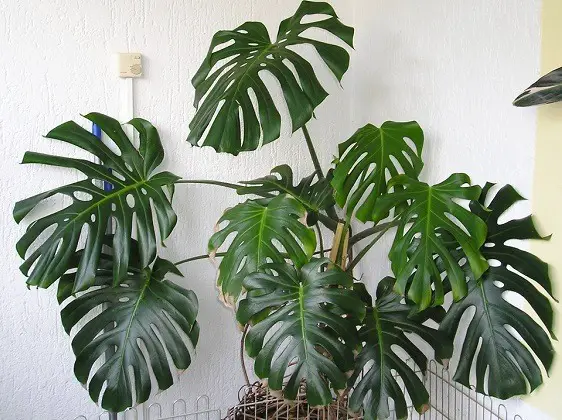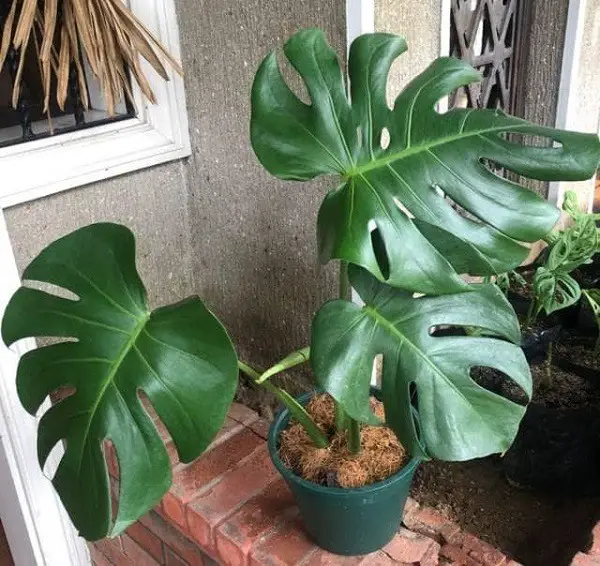There are different types of monstera plants in the world today. But many houseplant enthusiasts are more conversant with monstera deliciosa. It is the probable reason behind the confusion between monstera deliciosa and borsigiana.
So, what is the difference between monstera deliciosa and borsigiana? Monstera deliciosa has a wavy geniculum at the end of each petiole, whereas monstera borsigiana has a plain and straight leaf base that connects to the stem.
Continue reading this comparison article to identify more differences between monstera deliciosa and monstera borsigiana. I have also mentioned some close similarities between monstera deliciosa and borsigiana for better understanding.
You May Also Like: Difference between Monstera and Philodendron
Comparison Table (Monstera Deliciosa Vs Borsigiana)
| Comparison Terms | Monstera Deliciosa | Monstera Borsigiana |
| Geniculum | Has a wavy geniculum at the end of each petiole that meets the leaf. | Has a plain and straight leaf base that connects it to the stem. |
| Growth Habits | Has horizontal and sprawling growth habit. | Has a vining growth habit due to the long stems. |
| Leaf Size | Leaves can reach 3ft in length and width. | Leaves can reach 1.6 ft in width and length. |
| Growth Rate | Slow growth rate | Fast growth rate |
| Taxonomy | Liebm | Engl |
| Stem Structures | Shorter intervals between the stem nodes. | Longer intervals between the stem nodes. |
| Price | Quite expensive | Less expensive |
(Source: University of Florida)
What Is Monstera Deliciosa?

Monstera deliciosa hails from the Central American rainforest. The Swiss cheese plant species is also known as the split-leaf philodendron.
It is an eye-catching evergreen ideal for residential and commercial spaces. Most indoor monstera deliciosa experience a moderate growth rate.
The intricate Ariel roots with their leathery, glossy, characteristic split and heart-shaped leaves are the reason behind the skyrocketing prices in the market.
Monstera deliciosa care involves the provision of bright indirect sunlight, well-draining soil, regular watering, and feeding during the growing season (spring and summer).
Inappropriate growing conditions might result in brown leaf tips, yellow leaves, and wilting. I recommend plant inspection to identify the exact cause before finding the solution.
You Might Also Like: How to Care for Monstera Adansonii
What Is Monstera Borsigiana?

Monstera borsigiana is a sub-species of monstera deliciosa. The monstera species is small and experiences a rapid growth rate than the deliciosa.
Mature monstera borsigiana have dark-green leaves with perforations. These holes help the plant to tolerate heavy downpours and wind in its native habitat.
Monstera borsigiana fenestration has close similarities with those of deliciosa. But these fenestrations are large and numerous when compared to those of monstera deliciosa.
Borsigiana plants are excellent for creating monstera variegation. It is one of the reasons behind the numerous indoor monstera varieties in the market.
Monstera borsigiana care involves the provision of bright indirect sunlight, well-draining soil, high humidity, and regular watering during the growing season.
The monstera species is toxic to pets and toddlers if ingested. Be sure to keep your monstera borsigiana away from pets and children.
You May Also Enjoy: Why Is My Monstera Dying?
Main Differences between Monstera Deliciosa and Borsigiana
Leaf Size
Leaf size is the leading factor that helps to tell the difference between monstera borsigiana and monstera deliciosa. These two monstera species have different leaf sizes.
Monstera deliciosa leaves have an average length and width of 3ft. Outdoor monstera deliciosa leaves can reach up to 18-30 ft in size.
Monstera borsigiana leaves are smaller than those of deliciosa. The leaves grow up to 1.6 ft in length and width. It makes this monstera species ideal for indoor space.
Growth Rate
Most indoor plants do experience slow growth due to the location growing conditions. But most monstera varieties do experience excellent growth in any indoor space.
Monstera borsigiana plants have a fast-growing rate despite being small in size. It is the best option for houseplant enthusiasts living in apartments with limited space.
Monstera deliciosa plants experience a slow growth rate. The monstera species can reach 2-30 ft tall depending on its location and growing conditions.
Climbing Behavior
Most monstera varieties are tropical climbers. But other species that climbs more than others in their natural habitat. These climbing vines help to distinguish deliciosa from borsigiana.
Monstera deliciosa tend to grow horizontally with sprawling growth habits. The large leaves could be the leading reason behind the horizontal spreading.
Monstera borsigiana is smaller and tends to creep right away with the support of vines. I recommend training the plant to climb and enhance upward growth.
Stem Structure
Monstera varieties have unique stems due to the gap between the nodes. Some species have longer gaps, while others have shorter intervals.
Monstera borsigiana has longer intervals between the nodes to push for faster growth. The nodes also produce aerial roots that support the monstera species when climbing.
Monstera deliciosa have shorter internals between the stem nodes. It is the reason behind the slow growth rate and huge foliage development.
Cost
I always advise houseplant enthusiasts not to use price to help in choosing between two similar indoor plants. Some plant stores tend to exaggerate and rip off avid houseplants.
Monstera deliciosa is quite expensive, and prices tend to rise depending on your location or demand in the market. The high price is due to the ease of growth and maintenance.
Monstera borsigiana is a little bit cheaper in many online plant stores. The low price is due to the readily available variegated monstera for sale.
Geniculum
Geniculum is the leading dissimilarity between monstera deliciosa and monstera borsigiana. It is the joint of the stem that connects to the leaf or leafstalk.
Monstera deliciosa has a wavy geniculum at the end of each petiole that meets the leaf. The curvy texture is the reason why it is also known as ruffles.
Borsigiana has a typical geniculum like any other tropical plant since its geniculum has a smooth feeling due to its plain and straight nature. Geniculum helps to enhance leaf movement or flexibility.
You Can Also Read: Why Are My Monstera Leaves Not Splitting?
Similarities between Monstera Deliciosa and Borsigiana
Root System
Monstera deliciosa and borsigiana have the same root system despite having dissimilarities in leaf appearances. Both monstera species develop aerial roots at some point in life.
The aerial roots emerge from the stem nodes to absorb nutrients and moisture from the air. The primary roots are robust to support plant structures.
Perforated Leaf Structure
Both deliciosa and borsigiana have dark-green foliages with fenestrations. The glossy appearances and cuts make these monstera species attractive.
The leaf fenestrations tend to vary in size, number, and appearance. But these cuts are mostly oblong or semi-round in shape.
These natural leaf holes enable these tropical evergreen plants to tolerate heavy downpours and wind in their natural habitat.
Taxonomy
Taxonomy is a branch of science that deals with identification, classification and naming. These monstera species come from the same taxonomic unit.
The differences in species names are the reason behind the distinction between monstera borsigiana and deliciosa. (Source: Global Biodiversity Information Center).
Toxicity
Both monstera deliciosa and borsigiana plants are toxic to pets and humans. The stems and leaves contain a calcium oxalate compound that is poisonous if ingested.
I recommend keeping both monstera species away from children and pets. Besides that, it helps to protect the houseplant from destruction.
Growing Requirements
Monstera borsigiana and deliciosa belong to the same family. It implies that these monstera species have the same growing conditions.
- Light Requirements
Borsigiana and deliciosa thrive in bright indirect sunlight. But these tropical evergreen plants can also tolerate 3-4 hours of direct sunlight during the early morning or late evening.
- Watering Needs
Most monstera species prefer slightly moist potting soil. Too much or little soil moisture might ruin its appearance and health.
- Fertilizer Application
Monstera plants are not heavy-feeders like other tropical houseplants. Use water-soluble fertilizer rich in nitrogen to feed your plants during spring and summer.
- Temperature Range
The best temperature range for deliciosa and borsigiana is about 60-80oF (16-27oC). These monstera varieties do not tolerate freezing temperatures.
- Soil Requirement
Deliciosa and borsigiana do best in fertile and well-draining potting soil. The lightweight soil with proper aeration does not suffocate the roots.
You Can Also Read: How to Care for a Lipstick Plant
Conclusion
I hope you now have a full understanding of the difference between monstera deliciosa vs monstera borsigiana. Use the comment section to seek more assistance in telling differences and similarities.
I recommend buying monstera deliciosa over borsigiana. The large dark-green foliages with shiny appearances help to bring tropical vibes to any indoor space. Besides that, it has a long-lasting impression.